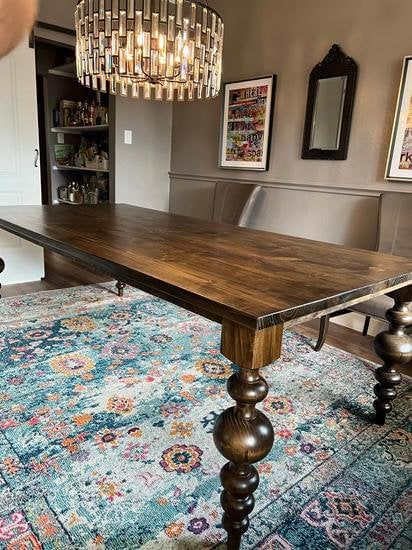The Top Trends in Dining Room Table Legs You Need to Know
The Top Trends in Dining Room Table Legs You Need to Know
Blog Article
From Typical to Modern: Locate the Suitable Dining-room Table Legs for Your Style
While classic layouts such as cabriole and transformed legs evoke a sense of ageless refinement, contemporary styles like barrette and geometric alternatives present an opportunity for striking aesthetic passion. As you take into consideration these elements, the concern continues to be: just how can you seamlessly integrate these diverse leg designs to develop an unified eating experience?
Comprehending Table Leg Styles
The range of eating space table leg designs can dramatically affect both the aesthetics and functionality of the space. Each leg style contributes distinct practical features and aesthetic components, accommodating varied style preferences and usage requirements. Understanding these designs is vital for selecting the ideal table that straightens with your overall interior layout vision.
For circumstances, conical legs offer a clean, traditional look that can enhance an area's style, while stand bases offer stability and optimize legroom, making them excellent for smaller sized spaces. Barrette legs, a trademark of mid-century contemporary design, present an industrial panache, enabling an airy, open feeling. In a similar way, trestle legs evoke rustic beauty, supplying robust assistance and a sense of timelessness.
Wooden legs can bring warmth and appearance, whereas metal alternatives often communicate a smooth, contemporary ambiance. Eventually, recognizing table leg styles is necessary for creating a cohesive eating location that reflects personal design while ensuring functionality and convenience.
Typical Table Leg Options
When selecting dining space table legs, typical choices usually embody timeless beauty and workmanship. These layouts mirror an abundant heritage and a dedication to quality, making them optimal for those who value traditional aesthetics.
One of the most renowned conventional leg styles is the cabriole leg, defined by its stylish rounded form. This style commonly includes ornamental carvings and is most typically discovered in Queen Anne and Chippendale furniture. One more popular option is the turned leg, which flaunts a collection of smooth, rounded forms that give a timeless appearance while preserving stability.
Additionally, the straight leg, while easy, provides a unadorned and sturdy framework that can mix effortlessly with a range of tabletop styles. For those drawn to ornate describing, claw-and-ball feet legs stimulate a feeling of magnificence and can serve as a stunning centerpiece in any kind of eating area.
Last but not least, pedestal bases, although not purely legs, give an alternative conventional alternative that permits enough legroom and can be perfectly carved. Each of these standard leg styles adds to the general ambiance of an eating space, marrying feature read with aesthetic allure.

Modern Table Leg Designs
Modern table leg layouts provide a varied variety of designs that highlight ingenious products and clean lines. These styles frequently focus on functionality while functioning as striking centerpieces within an eating space. Minimalist aesthetics prevail, with legs crafted from materials such as metal, glass, and crafted wood, which add to a ventilated and contemporary feel.
One preferred design is the barrette leg, identified by its slender, tapered framework that provides stability without frustrating the table top (dining room table legs). This style is typically located in mid-century modern furniture and can easily enhance various dining table forms. An additional trend is using geometric shapes, where legs might tackle asymmetrical great post to read or angular types, including aesthetic interest and a touch of artistry

Mixing Designs for Special Areas
Typically, house owners seek to create unique eating areas that show their personal design by mixing different design components. This technique permits the incorporation of varied aesthetics, causing an unified yet distinctive setting. Matching a rustic wood table with smooth, modern steel legs can create a distinctive comparison that elevates the space's overall charm.
Additionally, incorporating vintage table legs with contemporary table tops can evoke a feeling of history while keeping a contemporary perceptiveness. Such combinations not only display private preference but additionally encourage creative thinking, allowing home owners to curate an area that really feels both personal and inviting.
Shade plays a critical role in this blending procedure; choosing table legs that match or contrast with the existing color pattern can improve visual passion. Whitewashed legs can soften the boldness of a dark table surface, producing a well balanced aesthetic.
Tips for Selecting the Right Legs
Picking the right table legs is important click resources for accomplishing both capability and aesthetic charm in your eating room. Begin by considering the general design of your area. Traditional settings benefit from legs that include detailed makings or turned designs, while contemporary areas might ask for sleek, minimalist designs.
Following, analyze the elevation and stability of the legs. dining room table legs. Conventional table vary in between 28 to 30 inches in elevation, so make certain the legs complement this measurement for comfort. Additionally, robust materials, such as hardwood or metal, can enhance stability and durability
Examine the leg shape also-- choices consist of directly, tapered, or pedestal styles. Straight legs provide a traditional look, while tapered legs can add a touch of beauty. Pedestal bases offer sufficient legroom and are optimal for smaller sized areas.
Final Thought
In summary, selecting the ideal eating space table legs requires cautious consideration of both modern and typical designs. By harmonizing leg design, height, and product with the overall decor, a cohesive and welcoming environment can be attained.
The range of eating space table leg designs can substantially influence both the appearances and performance of the space. Inevitably, understanding table leg designs is important for developing a cohesive eating location that reflects individual style while making sure usefulness and comfort.One of the most legendary traditional leg designs is the cabriole leg, characterized by its stylish bent shape. Straight legs use a classic look, while conical legs can include a touch of beauty.In recap, picking the perfect eating area table legs requires cautious factor to consider of both modern-day and traditional styles.
Report this page